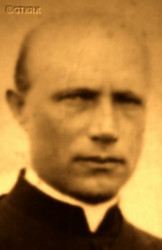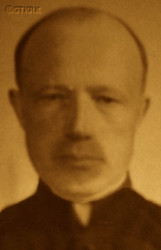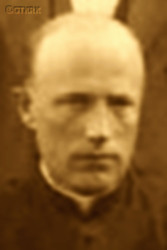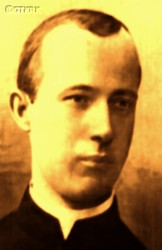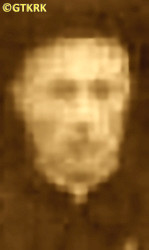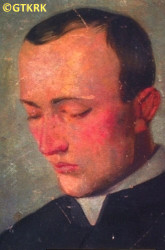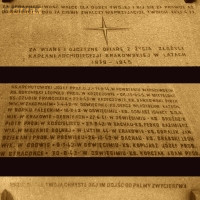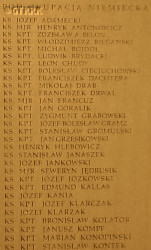Roman Catholic
St Sigismund parish
05-507 Słomczyn
85 Wiślana Str.
Konstancin deanery
Warsaw archdiocese, Poland
full list:
displayClick to display full list

searchClick to search full list by categories
wyświetlKliknij by wyświetlić pełną listę po polsku

szukajKliknij by przeszukać listę wg kategorii po polsku

Martyrology of the clergy — Poland
XX century (1914 – 1989)
personal data
surname
GÓRALIK
forename(s)
John (pl. Jan)
function
diocesan priest
creed
Latin (Roman Catholic) Church RCmore on
en.wikipedia.org
[access: 2014.09.21]
diocese / province
Cracow archdiocesemore on
en.wikipedia.org
[access: 2013.05.19]
RC Military Ordinariate of Polandmore on
en.wikipedia.org
[access: 2014.12.20]
honorary titles
Rochettum et Mantolettum canonmore on
en.wikipedia.org
[access: 2014.11.14]
(c. 1938)
Expositorii Canonicalis canonmore on
en.wikipedia.org
[access: 2014.11.14]
(c. 1936)
date and place
of death
26.10.1942

KL Dachauconcentration camp
today: Dachau, Upper Bavaria reg., Bavaria state, Germany
more on
en.wikipedia.org
[access: 2016.05.30]
details of death
Reserve chaplain of the Polish Armed Forces.
After German invasion of Poland on 01.09.1939 (Russians invaded Poland 17 days later) and start of the World War II arrested by the Germans on 02.09.1939 — in retribution for the death during the first day of war of German soldier in Podwilk Germans set alight a dozen or so houses and arrested c. 100 men. Dragged out straight from the confessional — the only one of the arrested who did not return to his home.
Forcibly marched to Trstená in Orava county in Slovakia, and then prob. to Ružomberok. Next interned in POW camps, such as Stalag XVII A Kaisersteinbruch, Oflag X A/Z Itzehoe and from 08.12.1939 Oflag IX C Rotenburg an der Fulda.
From there on 18.04.1940, in contravention of Geneva conventions of 27.07.1929, as a military POW transported to KL Buchenwald concentration camp. There every day slaved at excavations and a quarry, where was forced to carry „stones on his shoulder uphill every day — from dawn to dusk — with almost no respite”. Began to suffer from varicose veins. Co‐prisoners managed to convince a certain Czech prisoner — a surgeon — who secretly, after bribing German doctors, performed a surgery in the camp's „hospital” (a „revir” in camp language). Forced to leave the hospital after a few days, abandoned in front of the revir's barrack, and then saved and carried to the prisoner's barrack by a Czech Jew, on his back.
On 06‐07.07.1942 transported to KL Dachau concentration camp.
There, gangrene developed from the „continuously festering wounds”. On 26.08.1942 fell unconscious in the Germ. „Die Plantage”, the largest „herb garden” in Europe managed by the genocidal German SS, where slaved.
Carried on a stretcher to the camp hospital and perished there without regaining consciousness.
According to the death certificate, prepared in KL Dachau, the „honest” otherwise German „medical doctors” and formalists — and at the same time, unrivaled fairy tale spinners — noted that the cause of death was Germ. „Versagen von Herz und Kreislauf, bei Phlegmone am linken Unterschenkel” (Eng. „Heart and circulatory failure, due to phlegmon on the left lower leg”).
prisoner camp's numbers
31208Click to display source page (KL DachauClick to display the description), 1211Click to display source page (KL BuchenwaldClick to display the description)
cause of death
extermination: exhaustion and starvation
perpetrators
Germans
sites and events
KL DachauClick to display the description, KL BuchenwaldClick to display the description, Oflag IX C Rotenburg an der FuldaClick to display the description, Oflag X A/Z ItzehoeClick to display the description, Ribbentrop‐MolotovClick to display the description, Pius XI's encyclicalsClick to display the description
date and place
of birth
13.06.1889

Chróśćtoday: part of Staniątki village, Niepołomice gm., Wieliczka pov., Lesser Poland voiv., Poland
more on
en.wikipedia.org
[access: 2021.10.09]
alt. dates and places
of birth
Staniątkitoday: Niepołomice gm., Wieliczka pov., Lesser Poland voiv., Poland
more on
en.wikipedia.org
[access: 2021.10.09]
parents
GÓRALIK John
🞲 ?, ? — 🕆 ?, ?

NOSKOWSKA Mary
🞲 ?, ? — 🕆 ?, ?
presbyter (holy orders)
ordination
22.10.1911

Krakówtoday: Kraków city pov., Lesser Poland voiv., Poland
more on
en.wikipedia.org
[access: 2021.06.07]
positions held
1935 – 1939
dean — Orawadeanery name
today: Lesser Poland voiv., Poland RC deanery
1929 – 1935
deputy dean — Orawadeanery name
today: Lesser Poland voiv., Poland RC deanery
1928 – 1939
parish priest — Podwilktoday: Jabłonka gm., Nowy Targ pov., Lesser Poland voiv., Poland
more on
en.wikipedia.org
[access: 2021.12.18] ⋄ St Martin the Bishop and Confessor RC parish ⋄ Orawadeanery name
today: Lesser Poland voiv., Poland RC deanery
1927 – 1928
administrator — Podwilktoday: Jabłonka gm., Nowy Targ pov., Lesser Poland voiv., Poland
more on
en.wikipedia.org
[access: 2021.12.18] ⋄ St Martin the Bishop and Confessor RC parish ⋄ Orawadeanery name
today: Lesser Poland voiv., Poland RC deanery
1923 – 1927
vicar — KrakówZwierzyniec district
today: Kraków city pov., Lesser Poland voiv., Poland
more on
en.wikipedia.org
[access: 2021.06.07] ⋄ Most Holy Savior RC parish ⋄ Kraków Ideanery name
today: Lesser Poland voiv., Poland RC deanery
1919 – 1923
vicar — Cięcinatoday: Węgierska Górka gm., Żywiec pov., Silesia voiv., Poland
more on
en.wikipedia.org
[access: 2021.12.18] ⋄ St Catherine the Virgin and Martyr RC parish ⋄ Żywiectoday: Żywiec urban gm., Żywiec pov., Silesia voiv., Poland
more on
en.wikipedia.org
[access: 2021.06.07] RC deanery
1917 – 1919
vicar — Radziechowytoday: Radziechowy‐Wieprz gm., Żywiec pov., Silesia voiv., Poland
more on
en.wikipedia.org
[access: 2021.12.18] ⋄ St Martin the Bishop and Confessor RC parish ⋄ Żywiectoday: Żywiec urban gm., Żywiec pov., Silesia voiv., Poland
more on
en.wikipedia.org
[access: 2021.06.07] RC deanery
1911 – 1917
vicar — Rychwałdtoday: Gilowice gm., Żywiec pov., Silesia voiv., Poland
more on
en.wikipedia.org
[access: 2010.08.11] ⋄ St Nicholas the Bishop and Confessor RC parish ⋄ Żywiectoday: Żywiec urban gm., Żywiec pov., Silesia voiv., Poland
more on
en.wikipedia.org
[access: 2021.06.07] RC deanery
1907 – 1911
student — Krakówtoday: Kraków city pov., Lesser Poland voiv., Poland
more on
en.wikipedia.org
[access: 2021.06.07] ⋄ philosophy and theology, Department of Theology, Jagiellonian University UJ
1907 – 1911
student — Krakówtoday: Kraków city pov., Lesser Poland voiv., Poland
more on
en.wikipedia.org
[access: 2021.06.07] ⋄ philosophy and theology, Theological Seminary ⋄ Kraków RC archdiocese
others related
in death
BELONClick to display biography Zdislav Anthony, BRYDACKIClick to display biography Louis Cyprian, DACHTERAClick to display biography Francis, DRWALClick to display biography Francis, FRANCUZClick to display biography John, JĘDRYSIKClick to display biography Severin (Fr Vincent Mary), KLARZAKClick to display biography Joseph, KRYŃSKIClick to display biography Adolph Bernard, LISSOWSKIClick to display biography Ceslav Joseph, MICHUŁKAClick to display biography John, MIEGOŃClick to display biography Vladislav, STOPCZAKClick to display biography Marian Conrad, SYPERClick to display biography Stanislav, SZABELSKIClick to display biography Edward Bronislav, ŚWIDEREKClick to display biography Vladislav, TOMIAKClick to display biography Joseph, TRUSSClick to display biography Cyriac Boleslav, ZAKRZEWSKIClick to display biography John, ZIEMIAŃSKIClick to display biography Michael Urban, ZIĘBAClick to display biography Adalbert
sites and events
descriptions
KL Dachau: KL Dachau in German Bavaria, set up in 1933, became the main German Germ. Konzentrationslager (Eng. concentration camp) KL for Catholic priests and religious during World War II: On c. 09.11.1940, Reichsführer‐SS Heinrich Himmler, head of the SS, Gestapo and German police, as a result of the Vatican's intervention, decided to transfer all clergymen detained in various concentration camps to KL Dachau camp. The first major transports took place on 08.12.1940. In KL Dachau Germans held approx. 3,000 priests, including 1,800 Poles. The priests were forced to slave labor in the Germ. „Die Plantage” — the largest herb garden in Europe, managed by the genocidal SS, consisting of many greenhouses, laboratory buildings and arable land, where experiments with new natural medicines were conducted — for many hours, without breaks, without protective clothing, no food. They slaved in construction, e.g. of camp's crematorium. In the barracks ruled hunger, freezing cold in the winter and suffocating heat during the summer, especially acute in 1941‐1942. Prisoners suffered from bouts of illnesses, including tuberculosis. Many were victims of murderous „medical experiments” — in 11.1942 c. 20 were given phlegmon injections; in 07.1942 to 05.1944 c. 120 were used by for malaria experiments. More than 750 Polish clerics where murdered by the Germans, some brought to TA Hartheim euthanasia centre set up in Schloss Hartheim in Austria and murdered in gas chambers. At its peak KL Dachau concentration camps’ system had nearly 100 slave labour sub‐camps located throughout southern Germany and Austria. There were c. 32,000 documented deaths at the camp, and thousands perished without a trace. C. 10,000 of the 30,000 inmates were found sick at the time of liberation, on 29.04.1945, by the USA troops… (more on: www.kz-gedenkstaette-dachau.deClick to attempt to display webpage
[access: 2013.08.10], en.wikipedia.orgClick to attempt to display webpage
[access: 2016.05.30])
KL Buchenwald: In German Germ. Konzentrationslager (Eng. concentration camp) KL Buchenwald concentration camp, founded in 1937 and operational till 1945, Germans held c. 238,380 prisoners and murdered approx. 56,000 of them, among them thousands of Poles. Prisoners were victims of pseudo‐scientific experiments, conducted among others by Behring‐Werke from Marburg and Robert Koch Institute from Berlin companies. They slaved for Gustloff in Weimar and Fritz‐Sauckel companies manufacturing armaments. To support Erla‐Maschinenwerk GmbH in Leipzig, Junkers in Schönebeck (airplanes) and Rautal in Wernigerode Germans organized special sub‐camps. In 1945 there were more than 100 such sub‐camps. Dora concentration camp was initially one of them, as well as KL Ravensbrück sub‐camps (from 08.1944). On 08.04.1945 Polish prisoner, Mr Guido Damazyn, used clandestinely constructed short wave transmitter to sent, together with a Russian prisoner, a short message begging for help. It was received and he got a reply: „KZ Bu. Hold out. Rushing to your aid. Staff of Third Army” (American). Three days later the camp was liberated. (more on: www.buchenwald.deClick to attempt to display webpage
[access: 2013.08.10], en.wikipedia.orgClick to attempt to display webpage
[access: 2013.08.10])
Oflag IX C Rotenburg an der Fulda: German POW prisoner of war camp for officers in Rotenburg an der Fulda in Hesse. C. 60‐70 Polish Catholic priests, most of them military chaplains, captured by the Germans in 09.1939 during German invasion of Poland, were held POW there from 12.1939. In preparations for invasion of France all on 18.04.1940 were sent — in contravention of Geneva conventions of 27.07.1929 — to KL Buchenwald concentration camps. From 06.1940 Germ. Zweiglager (Eng. sub‐camp) of Oflag IX A/H Spangenberg and renamed Oflag IX A/Z. (more on: en.wikipedia.orgClick to attempt to display webpage
[access: 2019.11.17])
Oflag X A/Z Itzehoe: Founded in 01.1939 in Itzehoe in Schleswig‐Holstein and operational at least till 01.1941. First five POWs — a Polish general and 4 other officers — were brought in on 08.09.1939. Within next month at least 5 transports arrived at the camp, each with from 40 to 450 Polish soldiers. Altogether c 1,000 POWs were then held in the camp. Among them were 25 Catholic priests of which 21 were subsequently sent to German concentration camps. In mid 01.1941 Polish officers were moved to another POW camp, Stalag X‐B Sandbostel. (more on: www.shz.deClick to attempt to display webpage
[access: 2020.05.30])
Ribbentrop‐Molotov: Genocidal Russian‐German alliance pact between Russian leader Joseph Stalin and German leader Adolf Hitler signed on 23.08.1939 in Moscow by respective foreign ministers, Mr. Vyacheslav Molotov for Russia and Joachim von Ribbentrop for Germany. The pact sanctioned and was the direct cause of joint Russian and German invasion of Poland and the outbreak of the World War II in 09.1939. In a political sense, the pact was an attempt to restore the status quo ante before 1914, with one exception, namely the „commercial” exchange of the so‐called „Kingdom of Poland”, which in 1914 was part of the Russian Empire, fore Eastern Galicia (today's western Ukraine), in 1914 belonging to the Austro‐Hungarian Empire. Galicia, including Lviv, was to be taken over by the Russians, the „Kingdom of Poland” — under the name of the General Governorate — Germany. The resultant „war was one of the greatest calamities and dramas of humanity in history, for two atheistic and anti‐Christian ideologies — national and international socialism — rejected God and His fifth Decalogue commandment: Thou shall not kill!” (Abp Stanislav Gądecki, 01.09.2019). The decisions taken — backed up by the betrayal of the formal allies of Poland, France and Germany, which on 12.09.1939, at a joint conference in Abbeville, decided not to provide aid to attacked Poland and not to take military action against Germany (a clear breach of treaty obligations with Poland) — were on 28.09.1939 slightly altered and made more precise when a treaty on „German‐Russian boundaries and friendship” was agreed by the same murderous signatories. One of its findings was establishment of spheres of influence in Central and Eastern Europe and in consequence IV partition of Poland. In one of its secret annexes agreed, that: „the Signatories will not tolerate on its respective territories any Polish propaganda that affects the territory of the other Side. On their respective territories they will suppress all such propaganda and inform each other of the measures taken to accomplish it”. The agreements resulted in a series of meeting between two genocidal organization representing both sides — German Gestapo and Russian NKVD when coordination of efforts to exterminate Polish intelligentsia and Polish leading classes (in Germany called «Intelligenzaktion», in Russia took the form of Katyń massacres) where discussed. Resulted in deaths of hundreds of thousands of Polish intelligentsia, including thousands of priests presented here, and tens of millions of ordinary people,. The results of this Russian‐German pact lasted till 1989 and are still in evidence even today. (more on: en.wikipedia.orgClick to attempt to display webpage
[access: 2015.09.30])
Pius XI's encyclicals: Facing the creation of two totalitarian systems in Europe, which seemed to compete with each other, though there were more similarities than contradictions between them, Pope Pius XI issued in 03.1937 (within 5 days) two encyclicals. In the „Mit brennender Sorge” (Eng. „With Burning Concern”) published on 14.03.1938, condemned the national socialism prevailing in Germany. The Pope wrote: „Whoever, following the old Germanic‐pre‐Christian beliefs, puts various impersonal fate in the place of a personal God, denies the wisdom of God and Providence […], whoever exalts earthly values: race or nation, or state, or state system, representatives of state power or other fundamental values of human society, […] and makes them the highest standard of all values, including religious ones, and idolizes them, this one […] is far from true faith in God and from a worldview corresponding to such faith”. On 19.03.1937, published „Divini Redemptoris” (Eng. „Divine Redeemer”), in which criticized Russian communism, dialectical materialism and the class struggle theory. The Pope wrote: „Communism deprives man of freedom, and therefore the spiritual basis of all life norms. It deprives the human person of all his dignity and any moral support with which he could resist the onslaught of blind passions […] This is the new gospel that Bolshevik and godless communism preaches as a message of salvation and redemption of humanity”… Pius XI demanded that the established human law be subjected to the natural law of God , recommended the implementation of the ideal of a Christian state and society, and called on Catholics to resist. Two years later, National Socialist Germany and Communist Russia came together and started World War II. (more on: www.vatican.vaClick to attempt to display webpage
[access: 2023.05.28], www.vatican.vaClick to attempt to display webpage
[access: 2023.05.28])
sources
personal:
www.bj.uj.edu.plClick to attempt to display webpage
[access: 2012.11.23], uczyc-sie-z-historii.plClick to attempt to display webpage
[access: 2013.10.05], www.kurierorawski.plClick to attempt to display webpage
[access: 2015.09.30], www.ipgs.usClick to attempt to display webpage
[access: 2012.11.23], mbc.malopolska.plClick to attempt to display webpage
[access: 2020.05.25]
bibliographical:
„International Tracing Service (ITS), Bad Arolsen, GermanyClick to display source page”, Arolsen Archives
original images:
www.kurierorawski.plClick to attempt to display webpage
[access: 2015.09.30], uczyc-sie-z-historii.plClick to attempt to display webpage
[access: 2013.10.05], www.kurierorawski.plClick to attempt to display webpage
[access: 2015.09.30], tvpodhale.infoClick to attempt to display webpage
[access: 2015.09.30], doi.orgClick to attempt to display webpage
[access: 2021.10.09], hinterstacheldraht.jimdo.comClick to attempt to display webpage
[access: 2016.03.14], www.idziemy.plClick to attempt to display webpage
[access: 2020.05.25], www.facebook.comClick to attempt to display webpage
[access: 2015.09.30], www.katedrapolowa.plClick to attempt to display webpage
[access: 2014.01.16]
LETTER to CUSTODIAN/ADMINISTRATOR
If you have an Email client on your communicator/computer — such as Mozilla Thunderbird, Windows Mail or Microsoft Outlook, described at WikipediaPatrz:
en.wikipedia.org, among others — try the link below, please:
LETTER to CUSTODIAN/ADMINISTRATORClick and try to call your own Email client
If however you do not run such a client or the above link is not active please send an email to the Custodian/Administrator using your account — in your customary email/correspondence engine — at the following address:

giving the following as the subject:
MARTYROLOGY: GÓRALIK John
To return to the biography press below:
 Click to return to biography
Click to return to biography








